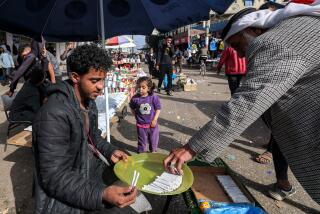On the outskirts of teeming Cairo, a refuge
- Share via
Reporting from Cairo — Past the wild dogs and poor boys selling charred corn and party hats, the road turns to dirt and stone and dips toward an ancient riverbed the colors of butterscotch and bone.
Fossils underfoot, foxes on the ridges, this is Cairo at the edge of the Eastern Desert, where the canyon cuts the sky and the smiling man in the entrance hut writes in a ledger and listens to chants from the Koran on his radio.
“Assalam alaikum.”
“Peace be upon you, too.”
My brother.
The city falls away, standing distant, a ragged sentinel in the smog. The wadi, the valley, is an escape. A sea millions of years ago, a parched serenity these days of boulders and gorges and slumped hillsides, all in muted browns and grays, like a sandstone winter before a snowfall. Clip on your iPod and run, past graffiti and tumbleweed plastic bags, past campfires and bikers, past girls in hijabs holding hands with their boyfriends in the crevice shade.
A bashful look, a stolen kiss; a whisper on the breeze. The wadi invites everyone: Westerners flash spandex and skin and jog toward SUVs holding coolers of beer and gin; modestly dressed Egyptians grill lamb and sip tea beneath the outcroppings. A Muslim prostrates in prayer; a sunburned man whacks golf balls off canyon walls. Hip-hop thumps; Arabic strings sharpen. Words are scrawled on rock in fire ash.
Ahmed.
Love.
Put a 20-million-year-old stone in your pocket. The wadi is forever, if factories stay at bay and trucks stop hauling away limestone and marble on the outskirts.
It was an unofficial dump, but now it’s a protected sanctuary, although trash still blows in the wind amid lizards and short-tailed bats. Boys and girls with big sacks and group leaders gather wrappers and bottles and camp under the stars, listening for stray dogs and footsteps in the night.
Sometimes, a bus delivers people in suits and nice shoes. They stroll for a while, search for artifacts, contemplate the land from which their civilization sprang and get back on the bus for the ride home.
Deep in the wadi, you can’t see or hear the city; you feel as if you are thousands of miles and milleniums away. But climb the ridges and Cairo rises on the smudged horizon. So crowded it appears, even in this hushed distance. It grows daily. Its population of 21 million sprawling from the banks of the Nile to the desert to farm fields of the northern Delta.
The poor live on rooftops, in cemeteries, on fishing boats. Trash heaps multiply. Fearful of a swine flu outbreak last year, the city slaughtered tens of thousands of pigs owned by garbage collectors to eat tons of refuse; a strange but delicate balance broken. Cairo is ceaseless energy, yet somehow weary, sustained by car horns, voices lost in traffic and the call to prayer that rings from minarets five times a day.
The city is not happy, the country is not happy. Workers strike; riot police gather. Schools are failing. Apartment buildings stand unfinished. Mechanics bang and hammer into the night. Intellectuals speak of a social explosion, but it doesn’t come, it simmers like steam in a lidded pot.
A clergyman said: “There is no one to guide us.”
A doctor at a public hospital said: “At least this place gives the poor a place to go, but the poor are too many. They’re frustrated and screaming over all we cannot give them.”
You can’t see this from the wadi’s ridges, but you can spot the gaps in the skyline, and men on motorcycles racing along cliffs and ledges, their scarves ribbons in the wind.
From up here, the wadi is a meandering dry river of stone and dust and thorny brush. When it rains, which is rare, the rivulets fill with water, feeding a thin stream that disappears with the sun.
When there is no rain, you turn up your iPod and run to where the ridge meets the sky. If you are lucky, and there’s a break in the smog, you will see, beyond Cairo, the pyramids of Giza standing hard against the sunset.
More to Read
Sign up for The Wild
We’ll help you find the best places to hike, bike and run, as well as the perfect silent spots for meditation and yoga.
You may occasionally receive promotional content from the Los Angeles Times.







